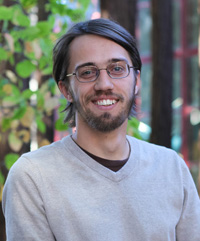Campus News
UCSC astrophysicist Charlie Conroy wins prestigious Packard Fellowship
The David and Lucile Packard Foundation has awarded a Packard Fellowship for Science and Engineering to astrophysicist Charlie Conroy.

The David and Lucile Packard Foundation has awarded a Packard Fellowship for Science and Engineering to Charlie Conroy, assistant professor of astronomy and astrophysics at the University of California, Santa Cruz.
The Packard Fellowship, one of the nation’s most prestigious honors for young faculty members, gives Conroy $875,000 over the next five years to support his research on the evolution of galaxies. Conroy is interested in how galaxies turn gas into stars and how those stars create the elements necessary for planets and life to arise.
“While we now have a solid predictive theory for the evolution of the universe on large scales, we possess only a dim understanding of how galaxies form stars and how those stars create the elements comprising the periodic table,” he said.
The present-day properties of a galaxy’s stars reflect the galaxy’s history, allowing Conroy to use “extragalactic archeology” to unravel the complex and sometimes mysterious lives of galaxies. Different elements form in different ways–some form in the cores of massive stars, others during supernova explosions, and so on. As a result, the detailed elemental abundance pattern of a galaxy is a “fossil record” of the galaxy’s history of star formation and galaxy assembly.
“The elements of the periodic table that we see in stars today tell us about what the galaxy was like when those stars formed, giving us insight into the properties of galaxies in earlier epochs,” Conroy said.
By studying both nearby and distant galaxies, he plans to chart the evolution of elemental abundances in galaxies over cosmic time and build a new framework to understand how galaxies and their stellar and elemental constituents evolve.
One way astronomers have studied galaxy evolution has been to observe galaxies at different distances from Earth, which correspond to different “look-back times” due to the time it takes for light to travel over cosmic distances. When a powerful telescope captures images of a galaxy billions of light-years away, we see the galaxy as it was billions of years ago. What has been lacking, however, is a way to figure out what type of nearby galaxy evolved from a given type of distant galaxy. Elemental abundance patterns could be the key to connecting galaxies across time, Conroy said.
Conroy is the 10th UCSC faculty member to receive a Packard Fellowship, awarded by the David and Lucile Packard Foundation to support young scientists and engineers who show exceptional promise and creativity. Previous recipients include astronomers Constance Rockosi and Enrico Ramirez-Ruiz in 2006 and 2008, respectively.
Conroy was awarded a Sloan Research Fellowship earlier this year. He earned a B.A. in physics and astrophysics at UC Berkeley and a Ph.D. in astrophysics at Princeton University. He was a Junior Fellow at Harvard University before joining the UCSC faculty in 2012.